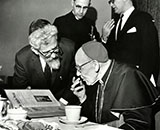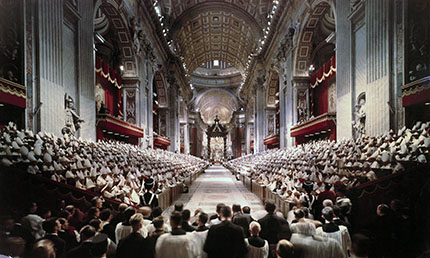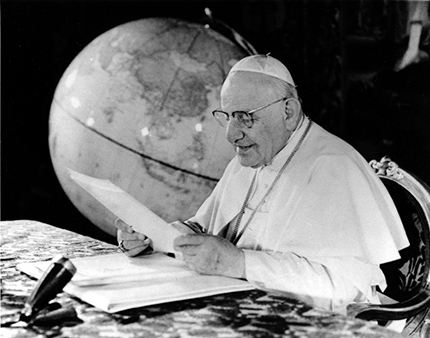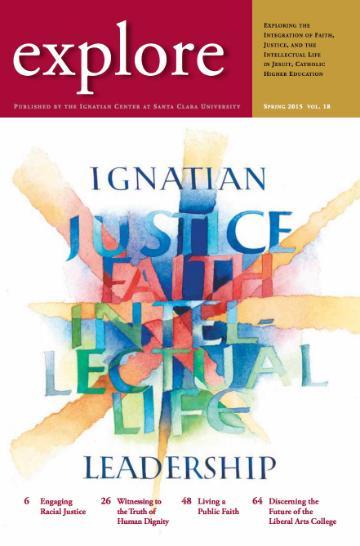
The Legacy of Ignatian Leaders at Vatican II
A Response to John O'Malley, S.J. and Rabbi Abraham Skorka

Good leadership is effective— visionary leadership proliferates. Good leadership can be measured, quantified, substantiated— visionary leadership cannot be captured by metrics but we know it when we see it. The theme of Ignatian Leadership is central to my work as a teacher and as a public theologian who studies the Catholic Church. Indeed, my particular interest is the Second Vatican Council. That great Council is saturated with visionary, Ignatian leadership.The Bannan events with Rabbi Skorka and Professor O’Malley put me in mind of several influential Jesuits who exercised such leadership at Vatican II. One could argue in fact, that without Cardinal Augustin Bea, S.J.’s leadership, the Council might not have made it to a second session; that is a speculation that I have used in the classroom to animate the conversation about the crucial debate around the relationship between the Bible and the Catholic teaching tradition. It is not speculative to say that without Cardinal Bea’s shrewd leadership, Pope John XXIII’s intention to heal the tragic relationship between the Catholic and the Jewish communities would not have flowered in the transformative way that it did. Good Pope John’s leadership was visionary because he knew that he could not direct it. He knew that his vision was meaningless unless it became the Council’s vision, that is, the shared intention of the worldwide pastors of the Church. At both Bannan events, I witnessed the effects of Ignatian leaders from the great Council from 1962-1965.
In crafting the event where the topic was dialogue and leadership, the conveners displayed canny insight. Rabbi Abraham Skorka did indeed give a talk that described his remarkable conversations and relationship with Archbishop Bergoglio, now Pope Francis. Yet Rabbi Skorka did not just talk about dialogue. He willingly entered the circle of the ongoing relationship between two leaders of their own Jewish and Catholic communities: Rabbi Dana Magat of Temple Emanu-El in San Jose, CA and Bishop Patrick McGrath of the Diocese of San Jose. Both pairs of leaders have built relationships of care and friendship. It was a compelling image: the rabbis and the bishop. Even more compelling for me however was the introduction by Santa Clara University’s recently tenured Jewish scholar, Professor Akiba Lerner. Without the visionary leadership that occurred at Vatican II, we would not have well-trained scholars from multiple religious traditions teaching at our Catholic universities. Professor Lerner elegantly summarized the foundation of the Council document that made Jewish-Catholic dialogue possible, Nostra Aetate, the “Declaration on the Relation of the Church to Non-Christian Religions.” It is not neutral cultural exchange but rather a commitment to “the ultimate mystery, beyond human explanation, which embraces our entire existence, from which we take our origin and towards which we tend.” Today, the presence of a Jewish scholar is essential in any Catholic theology faculty that is worthy of the name. Before Vatican II, Catholic universities did not give positions, let alone tenure, to scholars of Judaism. If the tradition was taught at all, it was usually under the topic “The Old Testament” and most likely taught by a Romantrained Catholic scholar, usually a priest. Here at Santa Clara, the religious studies department is the academic home for a young Jewish scholar who is honing his scholarship and teaching while raising his family in our own circle of dialogue. When we pass in the hallway around Holy Days in our department, we hear “Happy Hanukkah” as comfortably as we do “Merry Christmas.” Thus has the leadership of Cardinal Bea, S.J. proliferated.
Another tactical Jesuit genius at the Council was John Courtney Murray, S.J. If Bea’s influence was essential for propelling the Council to the theological cruising altitude where its progressive trajectory was not as vulnerable to the small but bureaucratically powerful regressive faction, Murray’s leadership helped the Council navigate the very challenging final sessions of the Council where the great Pastoral Constitution on the Church in the Modern World was threatened until the very end. Plagued by heart disease, Murray was in a hospital bed in Rome when the deeply discouraged Archbishop Marco McGrath came to see him. The regressive faction was trying to block the formulation of the Pastoral Constitution by flooding the committee with an unmanageable number of proposed revisions. McGrath told Murray that even if they could get through the revisions, the document would be long and cumbersome; it would look nothing like the elegant Dogmatic Constitution on Divine Revelation or the beautiful Dogmatic Constitution on the Church. Murray reassured the Archbishop, telling him that what mattered was that the document be accepted and sealed by the Council. The details mattered less than the form and vision of the document. For the first time a council of the Catholic Church was issuing a document that was pastoral in tone. Instead of condemning “modernism” as an anti-Catholic erroneous way of thinking, the Church was officially affirming the “modern world” and seeking to serve the entire human community.

The Jesuit, John O’Malley, S.J., has been exercising Ignatian leadership by making the vision of the Council come alive for decades. I knew I was in the presence of outstanding scholar when his remarks off-the-text were as illuminating as his prepared speech. My ears perked up even more when he said that over the last several years when he has been asked to speak about Vatican II he came away thinking, “I am really talking about something dead in the water.” I recognized that thought and the flattened feeling that accompanies it. But then he looked up and said intently, “I don’t feel that way today. I don’t feel that way at all. I think the Council with Pope Francis is almost as alive as it was in 1965.”4 Again, I experienced the legacy of visionary leadership embodied by this Jesuit scholar. But it was his insights about the extraordinary Jesuit Constitutions that made me sit higher in my seat. When he described how St. Ignatius of Loyola made use of the writings of a pagan, Cicero, to describe leadership, my eyes started to fill with tears. O’Malley noted the quality of magnanimity. The word rang like a bell in my head because that was the essential quality of the best leader I have ever known. The tears threatened because that leader, Fr. Richard McBrien, had died just the week before. It was fitting that Richard McBrien would move to the foreground of my thoughts as I listened to O’Malley. Both men have contributed significant scholarship on the life and mission of the Catholic Church. Though he was ordained a priest of the Archdiocese of Hartford Connecticut, McBrien earned his doctorate at the Jesuit Gregorian University in Rome. He often referred to himself as an honorary Jesuit. When he was hired by Fr. Hesburgh (then President of the University of Notre Dame) to bring his vision to the Department of Theology at Notre Dame, one of the first things he did was to write to the superior general of the Society of Jesus and ask that several Jesuits be appointed to teach for him. The Jesuits have always been deeply committed to Catholic education, so went his argument, and so the Society had a responsibility to contribute to building a world-class theology program at Notre Dame. The permission was granted and the Jesuit scholars came
It may have become a commonplace that the qualities of a good leader will saturate an institution, but that does not mean such leadership is common. Sadly, especially in the institutional church of the last several decades, many people who hold powerful positions influence by way of contraction. Not so McBrien, Murray, and Bea. They led with expansive vision. Not so Pope John, and certainly not so Pope Francis. In his opening remarks, O’Malley described Pope Francis as “bold, savvy, honest, transparent, and free.” Where will Ignatian leadership invite us next?

Sally Vance Trembath is on the faculty of Santa Clara University’s Department of Religious Studies, and earned her Ph.D. at the University of Notre Dame with a focus in ecclesiology, the theology of the Church. She has appeared frequently on television and radio to talk about Catholic issues. A native of Iowa, she and her family moved to San Francisco in 2001.
Endnotes
- Rabbi Abraham Skorka, “Interreligious Dialogue and Leadership: Building Relationships as Persons,” lecture, 2014–2015 Bannan Institute: Ignatian Leadership series, February 10, 2015, Santa Clara University. A video of the full lecture is available online at: scu.edu/ic/publications/videos.cfm
- Austin Flannery, ed., Vatican Council II: Vol. 1 The Conciliar and Post-conciliar Documents, Nostra Aetate, “Declaration on the Relation of the Church to Non-Christian Religions” (Northport, NY: Costello Publishing, 2004), 738.
- John O’Malley, S.J., “Looking at Vatican II with Pope Francis’ Eyes: Leadership and Spirituality,” lecture, 2014–2015 Bannan Institute: Ignatian Leadership series, Santa Clara Lecture, February 5, 2015, Santa Clara University. A video of the full lecture is available online at: scu.edu/ic/publications/ videos.cfm
- Ibid.
- Ibid.
